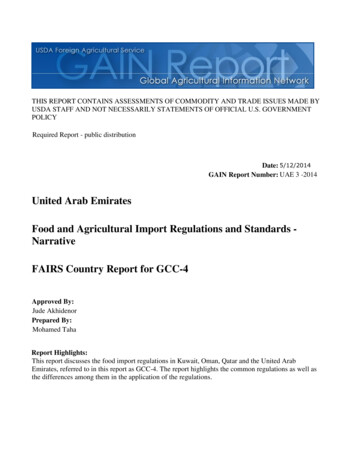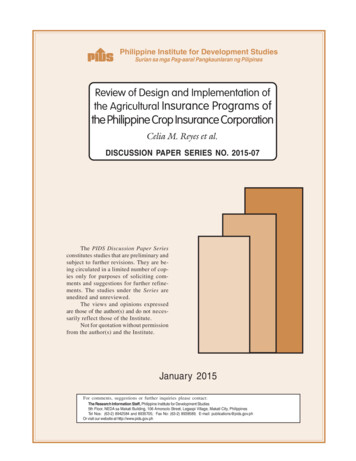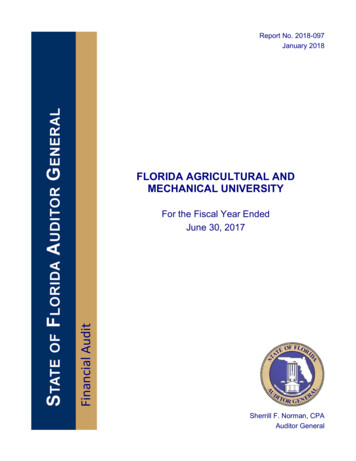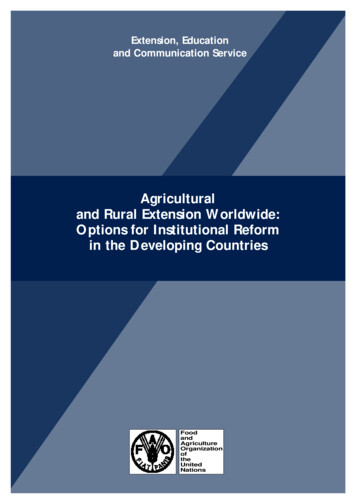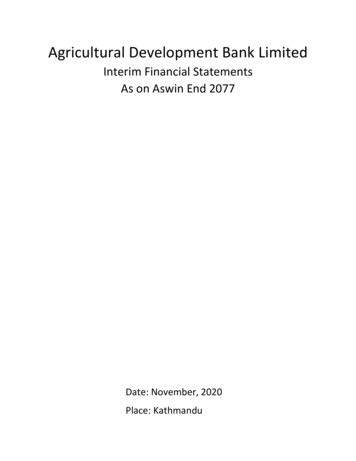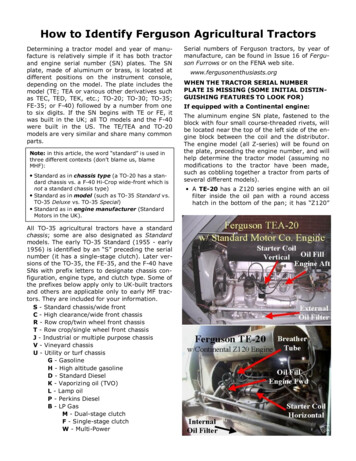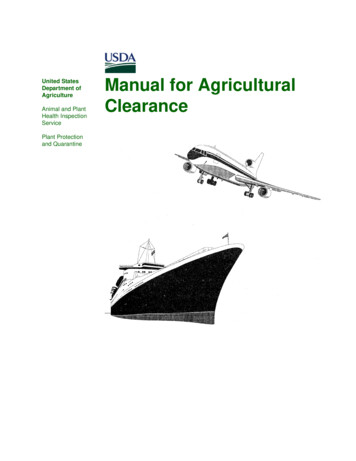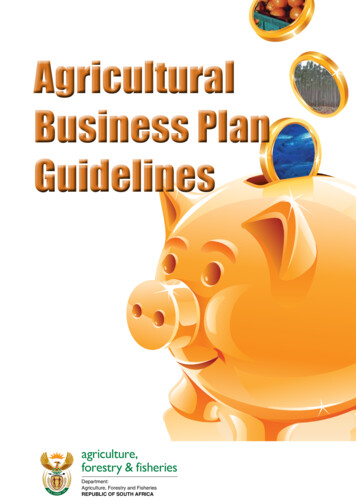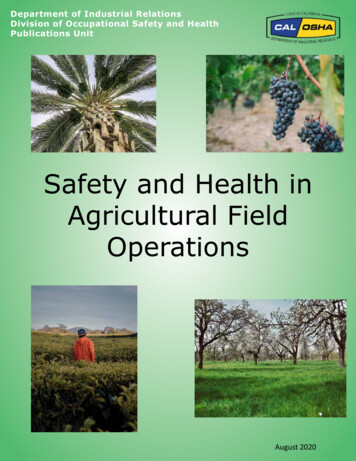
Transcription
Department of Industrial RelationsDivision of Occupational Safety and HealthPublications UnitSafety and Health inAgricultural FieldOperationsAugust 2020
This publication explains the functions of the California Occupational Safety andHealth (Cal/OSHA) Program and some common requirements of California lawand regulations for workplace safety and health. It is not intended to provideinterpretation of the law and regulations. The reader must refer directly to title 8of the California Code of Regulations and the California Labor Code for detailedinformation, specifications, and exceptions.Workplace safety and health information is available online at:General information: www.dir.ca.gov/doshCal/OSHA regulations: www.dir.ca.gov/samples/search/query.htmCal/OSHA safety and health publications: www.dir.ca.gov/dosh/puborder.aspCal/OSHA etools: www.dir.ca.gov/dosh/etools/etools.htmCal/OSHA Consultation Services offers free telephone, email, and onsite assistance. Find a local office online(www.dir.ca.gov/dosh/consultation.html) or with the contact information listed in the back of this document.
Table of ContentsTopicPageHow to Provide Safe Working Conditions .Having Effective Safety and Health Programs .12Having an Effective Injury and Illness Prevention Program (IIPP) .Following Instructions from the Manufacturers .26Providing Effective Training .6Selected Safety and Health Topics .7Power Take-Off (PTO) Safety .7Tractor Safety .8Farm Machinery and Equipment Safety .Aerial Device Safety .910Power and Hand Tool Safety .10Chain Saw Safety .11Wood Chipper Safety .Avoiding Field Sanitation Hazards .1112Protecting Workers from Heat Illness .Using Long-Handled Tools and Preventing Prolonged Stoop Labor .1316Preventing Skin Conditions and Other Injuries .Electrocution by Contact with High-Voltage Lines .Using Ladders Safely .Working Safely in Confined Spaces .Lighting and More .Preventing Slips, Trips, and Falls .171819212325Providing First-Aid and Medical Services .26Employee Training Topics .Using a Field Checklist .2730Applicable California Code of Regulations Title 8 (T8CCR) Standards .32Safety and Health Resources for Agricultural Field Operations .33Why Safety and Health Are Important .1This document is not meant to be a substitute for, or a legal interpretation of, the occupational safety and healthregulations. Readers must refer directly to Title 8 of the California Code of Regulations and the Labor Code for detailedinformation regarding the regulation’s requirements, scope, specifications, exceptions, and for other requirements thatmay be applicable to their operations.a
Safety and Health inAgricultural Field OperationsWhy Safety and Health Are ImportantEffective safety and health training and programs are important at agricultural worksites to protect farm workers from injuriesand illnesses. Operations in agricultural fields expose workers to serious and even fatal hazards. These hazards include but arenot limited to the following: Machinery-related hazards, such as driverless tractors, missing rollover protection and missing guards. Field sanitation hazards, such as the absence of toilet, handwashing, and drinking water facilities in the field. Heat-related hazards, such as strenuous work in high temperatures, and inadequate water and shade. Musculoskeletal hazards, such as hand weeding and the use of short-handled agricultural tools, and prolonged stooplabor and lifting. Skin-damaging hazards, such as lacerations from exposure to harvesting and pruning knives, thorns, and rashes fromexposure to soil contaminants, such as fertilizers and pesticides. Electrical hazards, such as working with metal ladders, pipes, or poles near high voltage electrical power lines.Cal/OSHA is committed to reducing the number of occupational safety and health hazards that farm workers are exposed tothrough enforcement of workplace safety and health regulations, phone and onsite consultation assistance to employers, andeducational assistance to farm workers and employers on agricultural safety. This guide is intended to help employers andtheir employees avoid accidents like those described below.Real Cases of Fatality and InjuryTractor Driver’s Head Crushed by Moving TractorA tractor driver fell to the ground when his tractor ran into a row of grapevines. As the tractor continued movingforward, a rear wheel crushed the tractor driver’s head. He died instantly.Fruit Picker Dies of Heat IllnessWhen fruit bags are full, they often weigh about 50 pounds. Workers carry them from the field to the truck, andcrews paid piece rate work at a fast pace. One fruit picker collapsed and died of heat stroke after just four hours of work.He was on a bus to go to another field when he began to pant and get sick to his stomach. The foreman stopped thebus and called an ambulance. The worker was taken to the hospital and treated, but he died 36 hours later of heat stroke.Employee Falls from Orchard LadderAn employee was helping harvest an orchard. The employee fell approximately 8 ft. from an orchard ladderand suffered head trauma, requiring hospitalization.How to Provide Safe Work ConditionsThe California Occupational Safety and Health Act of 1973 requires employers of farm workers, like all other employers inCalifornia, provide a safe and healthful workplace to their employees. Employers at farms, orchards, vineyards and otheragricultural settings can accomplish this by following all of the Cal/OSHA regulations required for their specific operations,such as: Implement an effective safety and health program.1
Follow safety instructions from the manufacturers of machinery, equipment, tools, vehicles, materials, supplies and otheritems used in the operations.Provide effective employee training.Having Effective Safety and Health ProgramsTitle 8 of the California Code of Regulations (T8CCR) (www.dir.ca.gov/samples/search/query.htm) contains several regulationsthat require employers to establish, implement, and maintain written safety and health programs that are extremelyimportant for maintaining safety in agricultural field operations. Here is a list of some of those regulations:3203 - Injury and Illness Prevention Program3220 - Emergency Action Plan3221 - Fire Prevention Plan3395 - Heat Illness Prevention5157 & 5158 - Confined Space5144 - Respiratory Protection5178 - Grain Handling Facilities5194 - Hazard CommunicationWhen your employees see that youhave effective safety and healthprograms, and follow them, theyknow you value their safety.Successful safety programs in high-risk industries, such as agriculture, have the following in common: Management commitment—Active involvement of supervisors and managers who know safety is part of their job. Worker involvement—Remember that your workers are your “eyes” in the field for hazard identification, and they oftenhave ideas for making a job safer. Worker involvement provides powerful motivation for improvement. Hazard elimination—Hazard identification and correction. Clear procedures and training — Employee and supervisor education on proper use and maintenance of equipment,including personal protection equipment, are critical elements of an effective safety and health program.Effective safety and health programs help employers follow all of the related title 8 requirements, which are designed toprotect employees from work-related injuries and illnesses.Employers need to promote safety and employee recognition for safe work practices. Employers also need to create a positiveenvironment in which employees can report unsafe work practices and hazards without fear of reprisal.Having an Effective Injury and Illness Prevention Program (IIPP)Every employer in California is required to have a written IIPP that includes, among other things:1. Management commitment to safety and assignment of responsibilities.2. A safety communication system with employees, including how they can obtaina copy of the written IIPP.3. A system for ensuring employee compliance with safe work practices.4. Scheduled workplace inspections/hazard evaluation system.5. Accident investigation.6. Procedures for correcting unsafe or unhealthy conditions.7. Safety and health training and instruction.8. Recordkeeping and documentation.The goal of the IIPP is to reduce workplace injuries and illnesses through theidentification and control of hazards as well as through employee training.Simply having a written IIPP does not fulfill the requirements. Employers musteffectively implement and ensure that the IIPP: Fully involves all employees, supervisors, and management. Identifies the specific workplace hazards employees are exposed to. Corrects the hazards in an appropriate and timely manner. Ensures effective training of employees and supervisors.2
Remember: How well the IIPP is put into practice will determine how effective it is. Employers must regularly review andupdate their IIPP in order for it to remain effective. Employers can use the following Cal/OSHA publications, etools andchecklist to establish, implement, evaluate, and improve their IIPP.Cal/OSHA Publications (www.dir.ca.gov/dosh/PubOrder.asp) for the IIPP: Workplace Injury & Illness Prevention Model Program for High Hazard Employers Workplace Injury & Illness Prevention Model Program for Employers with Intermittent Workers in Agriculture Guide to Developing Your Workplace Injury & Illness Prevention ProgramCal/OSHA eTool for IIPP (www.dir.ca.gov/dosh/etools/09-031/index.htm)IIPP ChecklistDo You Have an Effective IIPP?In order to prevent injuries, accidents, and illnesses, employers are required to implement and maintain an effective IIPP attheir workplace. This checklist will help you determine whether your current program meets minimum requirements. Payspecial attention to giving feedback to—and receiving it from—your workers. Make sure employees know how to to obtaina copy of the written IIPP. Go over each of these questions with them.If you answer “No” to one or more items, you will need to determine what information you are missing. You may need toseek further assistance or re-evaluate your existing IIPP.TopicYes No1. Have you designated a person with the authority and responsibility for implementing your Injury andIllness Prevention Program?Responsible person’s name:Do workers know who that person is?2. Do you have a system that ensures all workers are following safe work practices (for example, incentives orrewards for following safe work procedures, and established policies for disciplining unsafe behaviors)?What is it?Do you motivate your workers to work safely?Describe how:Do you discipline workers and supervisors who work unsafely and recognize those that work safely?Describe how:Do you train and retrain your workers to ensure the work is performed safely?Describe how and when:3. Do you have a system of effectively communicating with your workers and supervisors?Describe how: (include how employees will be able to obtain a copy of the written IIPP)Do workers report job hazards (such as damaged or defective equipment, broken ladders, tractors withdefective brakes, or unguarded machinery) or any other unsafe work conditions?Describe how:3
Do You Have an Effective IIPP? (Page 2)TopicYes NoAre safety and health complaints and suggestions responded to in a timely manner?Are rules clearly stated and written?Do workers regularly submit safety suggestions and report hazards?Describe how:Do you encourage employees to communicate with you?Describe how:Can workers inform management anonymously—or without fear of reprisal—about workplace hazards?Describe how:Do you encourage the reporting of safety violations, health hazards, or unsafe conditions?Describe how:Do you provide safety and health orientations for new employees?Describe how:Do you have frequent safety meetings for all employees?How often:4. Do you have an effective system for identifying job hazards and work practices, including conductingregular safety inspections?Describe how:Who is responsible for identifying hazards?How often do you conduct these inspections?Are additional inspections conducted if new substances, procedures, or equipment present new hazards?Do you inspect every new job site before work begins?What role do your workers have in identifying hazards and suggesting solutions?5. Do you have a system of investigating all work-related accidents that result in injury or illness?Who is responsible for investigating accidents?Do you interview injured workers and witnesses?Do you determine the main cause of the accident?Do you include recommendations from employees to prevent such accidents from recurring?Do you investigate “near misses” (situations that nearly result in an accident)?Do you know about the requirement to report serious injuries (www.dir.ca.gov/title8/342.htm) to Cal/OSHAwithin 8 hours?6. Do you have a system for correcting job hazards and work practices?What is it?4
Do You Have an Effective IIPP? (Page 3)TopicYes NoWho is responsible for correcting identified hazards?Do you prioritize correction of hazards based on how serious they are?Describe how:If a hazard cannot be corrected immediately, do you keep track of correction progress and follow up to ensurecorrection occurs in a timely manner?Describe how:During the time that a hazard is being corrected, do you keep workers—both those making the correction andthose who may be affected — safe?Describe how:7. Do you provide training to all new supervisors and workers about safety and health issues that affect themand hazards that are specific to their job assignments?Are workers trained about heat stress and high heat hazard procedures?Do you teach workers about emergency procedures, available medical services, first aid, and how to reportaccidents and unsafe conditions?Are workers trained in proper lifting techniques?Do you document the safety and health topics you cover?Do you teach workers about the use of appropriate clothing, including gloves, footwear, and personalprotective equipment?Are information and training for workers and supervisors provided in a language they understand?Do you train your supervisors on the hazards faced by the employees they supervise, and their responsibilitiesto protect those employees from those hazards?Do you teach workers about safe practices for operating or using any agricultural equipment, includingprocedures for cleaning, repairing, servicing and adjusting?Do you train your supervisors about their responsibility to address reported hazards and not to discouragereporting or retaliate against workers who make safety complaints?8. Do you document your safety and health efforts?Describe how:Are safety and health orientations for new workers documented?Describe how:Are inspections and hazard corrections documented?Are safety training sessions documented?Are all investigations of accidents documented?Do your reporting forms make clear that workers will not be retaliated against for filing a complaint?5
Following Instructions from the ManufacturersAgricultural work is performed with a variety of machinery, equipment and tools. T8CCR section 3328(b) requires thatmachinery and equipment in service be inspected and maintained as recommended by the manufacturer where suchrecommendations are available. Many accidents and injuries occur because employees are not familiar with or are notfollowing these instructions.Manufacturers’ instructions on how to use equipment or tools generally include warnings and information that arecommunicated with both words and pictures.An example of a written warning is “WARNING, HAND ENTANGLEMENT IN AUGER.” Thisinstructs users not to place hands in the auger. The picture to the right conveys the samewarning.Failure to following this instruction can cause very serious injuries.Informational instructions are usually provided through user’s guides and maintenancemanuals.Some important things to remember: Ask manufacturers for instructions in a language the workers understand. When manufacturers’ instructions are not available, provide the employees with bestpractices on how to use the equipment/tool. Provide all the tools and safety equipment needed to follow the manufacturer’s instructions. Have an experienced person demonstrate how to work safely with the equipment and tools. Provide training on each machine, tool, and piece of equipment.Providing Effective TrainingTraining of employees is a key to providing a safe work environment and worker safety, and is required by Cal/OSHA.Manufacturers of machinery, equipment, and tools expect the users to be trained on them before use. Follow these steps toconduct effective training: Relate the training directly to the work being performed by the employees. Provide practical information about potential hazards. Communicate using a language and methods understandable to all employees. Establish a relationship with employees to improve trust and communication. Involve employees by drawing on their own real-life experiences. Practice group hazard identification and problem solving by means of demonstrations, asking questions, discussing ideas,etc. Provide opportunities to demonstrate best work practices and the safe use of machinery, tools, equipment, materials, etc. Provide training to employees when hired and rehired, and as often as necessary. Assure workers that they won’t face retaliation for reporting hazards.Effective workplace training involves the following steps: Identify topics to cover. Set training goals and objectives. Plan the trainings and organize materials. Conduct the training. Check for understanding and get feedback.6
Selected Safety and Health TopicsAgricultural field operations include a large variety of equipment, such as the following: Farm machinery and equipment including harvesters, cultivators, plows and discs, planters and transplanters, fertilizerand manure spreaders, produce sorters, and balers Power tools and hand tools Industrial tractors, aerial devices, and boom trucks Irrigation equipment used for surface irrigation, piped network,drip system, center pivot, and wheel line drop systems Water pumps, sumps, pits, and grain silos Ladders, including orchard ladders Truck-mounted tree shakers and other orchard equipment Tractor-mounted tree trimmers Chippers and chain sawsFarming machines typically have hazardous moving,
Electrocution by Contact with High-Voltage Lines 18 . Using Ladders Safely 19 . Working Safely in Confined Spaces 21 . Lighting and More 23 . Preventing Slips, Trips, and Falls 25 . Cal/OSHA is committed to reducing the number of occup

